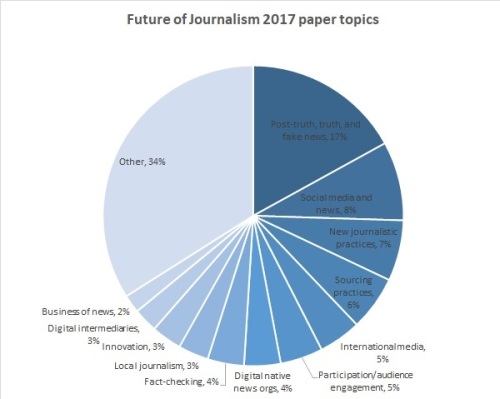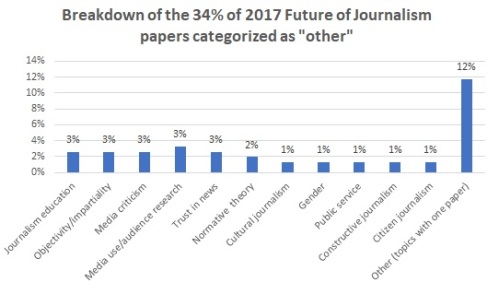I’m at the 2017 Future of Journalism conference in Cardiff, one of the most important academic journalism studies conferences in the world, with more than 200 participants from Europe, the US, and beyond. Over 150 papers will be presented, many of them will later be published in some of the field’s top journals.
All these papers are work-in-progress, fresh, recent, up-to-date work by a wide range of academics studying journalism from a range of perspectives, from a range of background, from a range of countries.
In combination, they provide a basis for at least a partial answer to the question of what journalism studies is actually studying today.
So I did a quick and subjective categorization of all the paper titles by topic. (This is not a formal content analysis, and I did this on my own. For a more rigorous recent meta-analysis of the field, see this piece by Laura Ahva and Steen Steensen.) The results are below. I categorized the 150+ papers by their title, and collapsed all topics with less than 5 papers into “others”.
I found the results quite interesting – in part as a reminder how where academic research overlaps with pressing civic, professional, industry, and policy-maker concerns (and where it does not), in part as an illustration of how the academic community collectively gather around certain topics in bottom-up ways with little in terms of explicit, coordinated discussion of what “the field” “should do”.

The bulk of the presenters and the bulk of the presentations are from and focused on high income democracies, so there are a whole range of issues around state censorship, freedom of expression, violence against journalists, media capture, and other very pressing issues that are largely absent.
Given the focus on high-income democracies, a couple of stand-outs from me—
- Lots of discussion of post-truth and fake-news, from what I have seen presented so far often critical of how these terms are used, but also a case of academics latching on the fashionable terms. (It is interesting that there is relatively little audience research in general, and on this in particular–though Irene Costera Meijer and Tim Groot Kormelink had interesting data and analysis.)
- Discussion of social media, search engines, and messaging apps is primarily focused on what news organizations and ordinary users do with platform companies’ products and services (especially social media) (lot’s of Twitter buzz around Shannon MacGregor‘s presentation–I did not hear it myself), and not on what platform companies do to the wider media environment (discussions of digital intermediaries).
- Much work is being done on new journalistic formats and practices (data journalism, fact-checking, use of analytics, virtual reality, etc.) and growing body of work on digital-born news organizations—this is important and encouraging, work by Jane Singer, Valerie Belair-Gagnon and others.
Conspicuous absences, in my view—
- The business models that funded most of journalism as we knew it are being fundamentally challenged by the move to digital media, the proliferation of choice for both audiences and advertisers, and the rise of platform companies, and in my view the question of new funding models is one of the most important ones today—yet we see, at least at this conference, very little work on it. One paper on willingness to pay, two on native advertising. (Richard Fletcher and I have done some work on this, I have a handbook chapter here, Jay Hamilton’s more than ten years old book remains a classic as is work of Robert Picard.)
- Beyond that, the question of innovation and entrepreneurship, of constant organizational change in legacy and digital-born news media seems of central importance to me, and has been the subject of a fair amount of work in the past, but little at this conference. (I look to Lucy Kung for work on this, have also done some with Alessio Cornia and Annika Sehl on some of these issues, see various reports here, here, and here.)
- Similarly, the way in which platform companies are part of a structural transformation of our media environments, for good, for ill, in all its nuance and complexity, is a monumental change with profound consequences for journalism and news media, but one we, at least here, see little academic research on. (Sarah Ganter and I have done some work on this and more to come, Jose van Dijck, Tarleton Gillespie and Frank Pasquale are among my go-to sources outside journalism studies).
Finally, a couple of classic and important topics that have seen quite few papers at least at this conference—
- I saw only one paper title on television news. Less important than in the past, surely, and historically always under-researched in journalism studies, but still incredibly important and widely used, especially by older people (who can decide elections! See Trump and Brexit…) I like Stephen Cushion’s work on this as well as older work by Russ Neuman and colleagues.
- Two papers on public service media. Given the estimated the estimated annual investment of about €16.6 billion in public service provision across Europe alone, their importance, widely varying performance, different challenges including political pressure and need to develop digital offerings, that seems like a topic worth a bit more investigation.
- One paper on inequality. Given the a development where many societies are more and more unequal in many ways, and given that we have reasons to believe that the move from a low-choice to a high-choice media environment may increase already significant information inequalities as people (often affluent and highly educated) who are very interested in news consume more and more, and those less interested (often less affluent and with less formal education) may consume less and less as other offerings catch their attention, this bears more work it seems to me.
So, much interesting work being presented, some interesting absences, which presents opportunities for important research in the future.
UPDATE
People have asked for a break-down of the 34 percent categorized as “other” in the pie chart. Below is a bar chart where topics addressed by only one paper are collapsed into “other” but the remaining parts are broken out by topic. Note, as explained above, some of the categories above are already aggregates, e.g. “new journalistic practices” include work on bots, automated content, computational journalism, data journalism, VR, and newsroom use of audience analytics.

